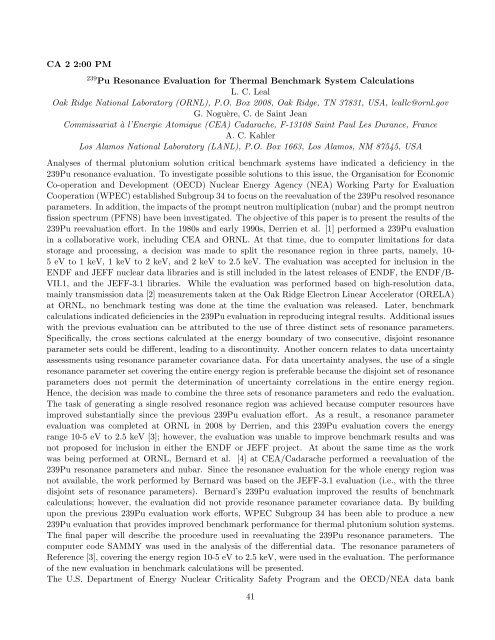Program - Brookhaven National Laboratory
Program - Brookhaven National Laboratory
Program - Brookhaven National Laboratory
Create successful ePaper yourself
Turn your PDF publications into a flip-book with our unique Google optimized e-Paper software.
CA 2 2:00 PM<br />
239 Pu Resonance Evaluation for Thermal Benchmark System Calculations<br />
L. C. Leal<br />
Oak Ridge <strong>National</strong> <strong>Laboratory</strong> (ORNL), P.O. Box 2008, Oak Ridge, TN 37831, USA, leallc@ornl.gov<br />
G. Noguère, C. de Saint Jean<br />
Commissariat à l’Energie Atomique (CEA) Cadarache, F-13108 Saint Paul Les Durance, France<br />
A. C. Kahler<br />
Los Alamos <strong>National</strong> <strong>Laboratory</strong> (LANL), P.O. Box 1663, Los Alamos, NM 87545, USA<br />
Analyses of thermal plutonium solution critical benchmark systems have indicated a deficiency in the<br />
239Pu resonance evaluation. To investigate possible solutions to this issue, the Organisation for Economic<br />
Co-operation and Development (OECD) Nuclear Energy Agency (NEA) Working Party for Evaluation<br />
Cooperation (WPEC) established Subgroup 34 to focus on the reevaluation of the 239Pu resolved resonance<br />
parameters. In addition, the impacts of the prompt neutron multiplication (nubar) and the prompt neutron<br />
fission spectrum (PFNS) have been investigated. The objective of this paper is to present the results of the<br />
239Pu reevaluation effort. In the 1980s and early 1990s, Derrien et al. [1] performed a 239Pu evaluation<br />
in a collaborative work, including CEA and ORNL. At that time, due to computer limitations for data<br />
storage and processing, a decision was made to split the resonance region in three parts, namely, 10-<br />
5 eV to 1 keV, 1 keV to 2 keV, and 2 keV to 2.5 keV. The evaluation was accepted for inclusion in the<br />
ENDF and JEFF nuclear data libraries and is still included in the latest releases of ENDF, the ENDF/B-<br />
VII.1, and the JEFF-3.1 libraries. While the evaluation was performed based on high-resolution data,<br />
mainly transmission data [2] measurements taken at the Oak Ridge Electron Linear Accelerator (ORELA)<br />
at ORNL, no benchmark testing was done at the time the evaluation was released. Later, benchmark<br />
calculations indicated deficiencies in the 239Pu evaluation in reproducing integral results. Additional issues<br />
with the previous evaluation can be attributed to the use of three distinct sets of resonance parameters.<br />
Specifically, the cross sections calculated at the energy boundary of two consecutive, disjoint resonance<br />
parameter sets could be different, leading to a discontinuity. Another concern relates to data uncertainty<br />
assessments using resonance parameter covariance data. For data uncertainty analyses, the use of a single<br />
resonance parameter set covering the entire energy region is preferable because the disjoint set of resonance<br />
parameters does not permit the determination of uncertainty correlations in the entire energy region.<br />
Hence, the decision was made to combine the three sets of resonance parameters and redo the evaluation.<br />
The task of generating a single resolved resonance region was achieved because computer resources have<br />
improved substantially since the previous 239Pu evaluation effort. As a result, a resonance parameter<br />
evaluation was completed at ORNL in 2008 by Derrien, and this 239Pu evaluation covers the energy<br />
range 10-5 eV to 2.5 keV [3]; however, the evaluation was unable to improve benchmark results and was<br />
not proposed for inclusion in either the ENDF or JEFF project. At about the same time as the work<br />
was being performed at ORNL, Bernard et al. [4] at CEA/Cadarache performed a reevaluation of the<br />
239Pu resonance parameters and nubar. Since the resonance evaluation for the whole energy region was<br />
not available, the work performed by Bernard was based on the JEFF-3.1 evaluation (i.e., with the three<br />
disjoint sets of resonance parameters). Bernard’s 239Pu evaluation improved the results of benchmark<br />
calculations; however, the evaluation did not provide resonance parameter covariance data. By building<br />
upon the previous 239Pu evaluation work efforts, WPEC Subgroup 34 has been able to produce a new<br />
239Pu evaluation that provides improved benchmark performance for thermal plutonium solution systems.<br />
The final paper will describe the procedure used in reevaluating the 239Pu resonance parameters. The<br />
computer code SAMMY was used in the analysis of the differential data. The resonance parameters of<br />
Reference [3], covering the energy region 10-5 eV to 2.5 keV, were used in the evaluation. The performance<br />
of the new evaluation in benchmark calculations will be presented.<br />
The U.S. Department of Energy Nuclear Criticality Safety <strong>Program</strong> and the OECD/NEA data bank<br />
41
















